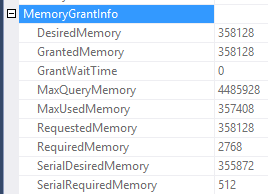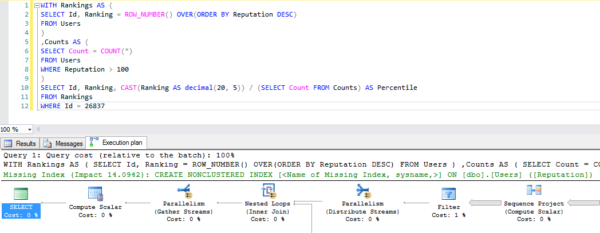When you see a yellow bang in an execution plan, and you hover over it to discover that SQL Server spilled out to TempDB, your first reaction is to wail in pain and rend your clothes.

After that, though, it seems like people always ask the same question:
“Why doesn’t updating stats fix this?”
In the example here, I’m using Cade Roux’s rank-and-percentile query against the Stack Overflow data dump. It’s not that statistics are out of date – look at the estimated number of rows versus the actual number of rows.
They’re identical. The stats are fine.
And no matter how many times I update statistics, I’ll still get a ~400MB spill to disk.
I’m not using a small server, either: my virtual machine has 32GB RAM, and I’ve allocated 28GB of that to SQL Server. There are no other queries running at the same time – it’s just one lonely query, spilling to disk for the lack of 400MB RAM.
When I right-click on the SELECT operator and click Properties, I get the fancy properties window in SSMS, which shows me more details about the query’s memory grants:

Note the rigorous devotion to alphabetical order in the properties window. It’s up to you, dear reader, to figure out what you’re supposed to read, in which order. Here, I’ll give you a peek at my decoder ring:
- DesiredMemory – look here first. It’s how much memory SQL Server wanted.
- RequestedMemory – sometimes, this is less than desired. (I’d really like a Porsche 911R, but I know better than to ask my wife for the budget to buy one.)
- GrantedMemory – how much I actually got.
SQL Server wasn’t off by too much: this operator only needed 7,643 more 8KB pages, around 60MB. Close – but no cigar.
Fixing it with the claw hammer: MIN_GRANT_PERCENT
Starting with SQL Server 2012 SP3, 2014 SP2, and 2016, I have a nifty new query option:
|
1 |
OPTION (min_grant_percent = 50) |
That brains SQL Server into giving me all the memory I need, and then some. The spill is gone from the execution plan, and my memory grants are way higher:

But this has a terrible drawback: I’m claiming memory that no one else can use while my query runs. And how do I know if I even got that grant percent right, anyway? It’ll change over time as my data changes.
Fixing it with the scalpel: CREATE INDEX
Whenever you’re tuning queries, look at the big picture: if the data was already sorted in the order you needed, you wouldn’t be having this problem with the sort operator. And SQL Server’s trying to give you a hint in the form of a missing index recommendation:

That impact number might seem low at just 14, but remember – that’s a suggestion SQL Server came up with before it even executed the query. Before the query ran, it didn’t even know about the TempDB spill, so the impact’s going to be even larger.
Can you fix every spill? Of course not – sometimes, you’re dealing with data that’s larger than the physical box’s memory. But even when you can fix it, just make sure you’re fixing it with the right tool.


8 Comments. Leave new
What I still don’t get from your example is why the data was spilled to tempdb. SQL Server got all the memory it requested (GrantedMemory = DesiredMemory). However, it used only 357408KB (MaxUsedMemory). Why? Whyyyyy???
Heh heh heh – the memory grant is overall, for the entire query. Individual operators don’t get the whole grant.
[…] Update – Brent ended up doing a longer blog about spillage that’s quite a bit easier to follow than my ramblings. You can find it here […]
Thank you Brent .This was presented very well.JUST as FYI,operator level grants will be visible in next release of ssms..
https://blogs.msdn.microsoft.com/blogdoezequiel/2016/12/09/extended-per-operator-level-performance-stats-for-query-processing/
The blog i referred seems to be very old,but still i can’t see the memory grant option in SSMS..please ignore the above
comment,i wish i could delete it
Hi Brent!
Thanks for this great post!
I had this problem with SQL Server 2016.
The problem has been fixed in the 2019 version.
Bad news: it hasn’t, and I show why in my Mastering Query Tuning class. See you there!
Ok Brent!
But in my case, there is no spill to tempdb.
After upgrading to SQL Server 2019.
Thanks!